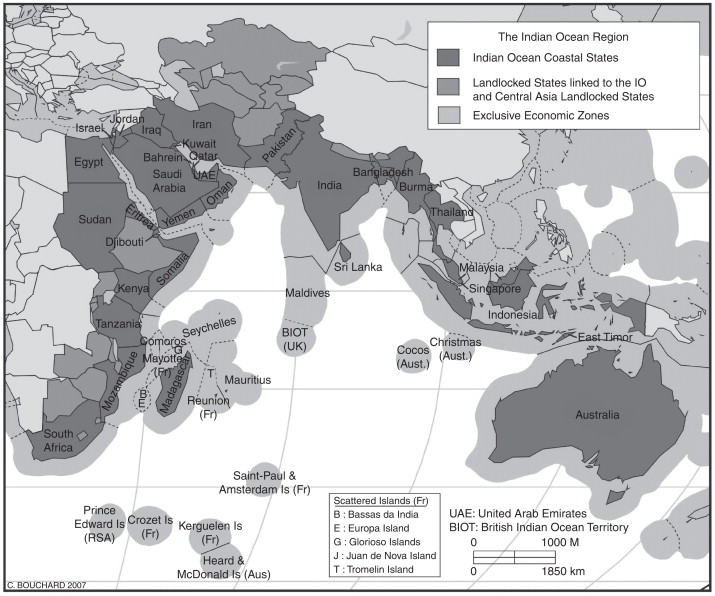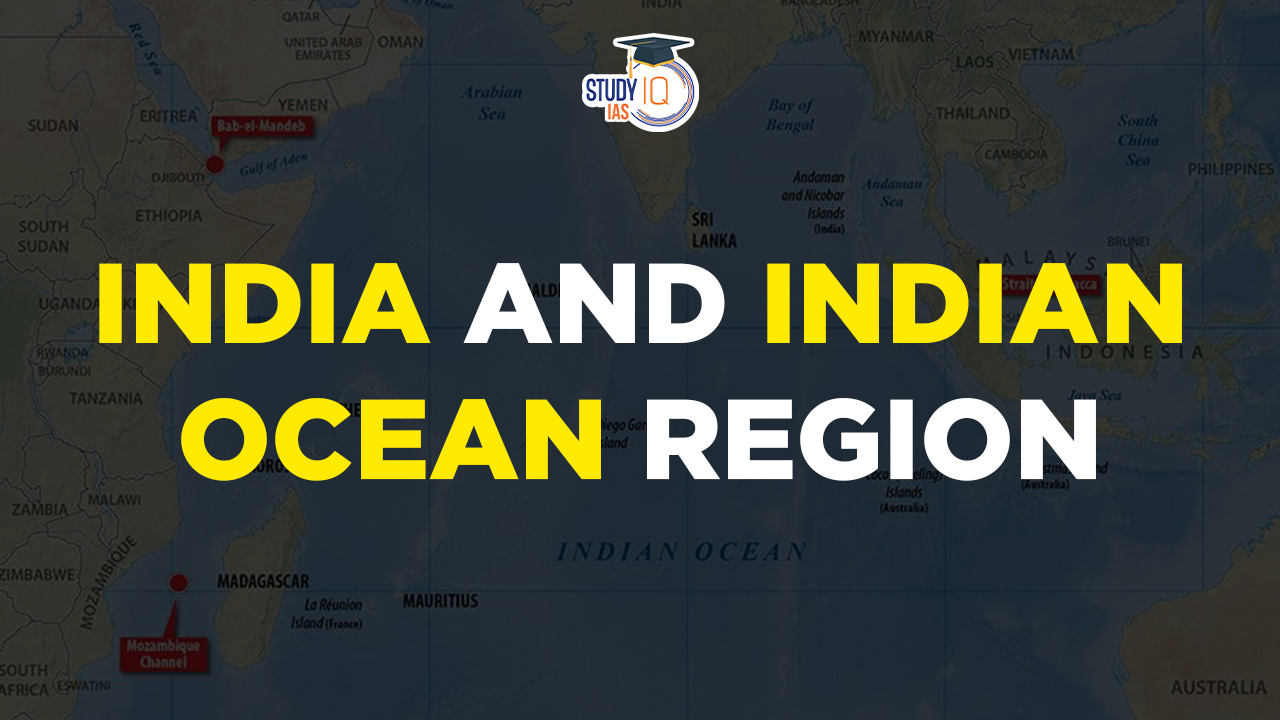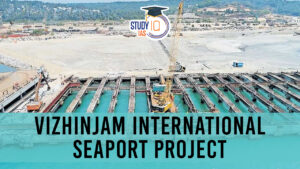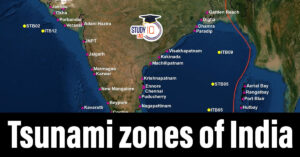Table of Contents
Context: India must act as a unifier in the Indian Ocean Region (IOR) to ensure maritime security, counter China’s influence, safeguard trade routes, and promote regional stability through strategic leadership.
Indian Ocean Region (IOR)
- Indian Ocean is the third largest water body in the world.
- It is also known as the ‘sea of stability’.
- It acts as a lifeline to international trade and transport as it carries one-third of the world’s bulk cargo traffic and two-thirds of the world’s oil shipments (driving the economic vibrancy in Asia and Europe)
- Indian Ocean contains a great degree of wealth in the form of an abundance of oil, natural gas, and minerals.
- While the strategic and economic pivots are shifting to make the Indo-Pacific general, India has maintained trade and civilizational links with countries in the region since time immemorial.

Why India Must Act as a Unifier in the IOR
- Trade Importance: Approximately 70% of India’s oil imports are channelled through the Indian Ocean region, utilising various ports.
- The vast majority of India’s international trade, around 90% by volume, heavily relies on maritime routes.
- Geostrategic Importance: India’s central location in the IOR provides a strategic advantage to influence regional security and trade.
- Counterbalance to China’s Expanding Presence: China’s growing influence through projects like the String of Pearls and military bases in the IOR threatens regional stability.
- India must lead regional cooperation to counter China’s strategic dominance.
- Ensuring Maritime Security: Piracy, smuggling, and maritime terrorism pose direct threats to India’s trade and security (Eg., Golden Crescent and the Golden Triangle).
- A unified regional framework can strengthen maritime surveillance and collective response mechanisms.
- Leveraging SAGAR for Regional Leadership: India’s SAGAR (Security and Growth for All in the Region) doctrine positions India as a security provider and development partner.
- Leading initiatives on maritime security, trade, and disaster relief can enhance India’s influence and credibility.
- Economic and Energy Security: IOR nations are key trade and energy partners for India, especially in oil and gas imports.
- Ensuring secure and stable sea lanes is critical for India’s economic growth and energy security.
- Diplomatic and Strategic Autonomy: Acting as a unifier will position India as a reliable and independent power in the region.
- A balanced and cooperative approach will allow India to engage with both regional and extra-regional powers without compromising its strategic interest.
How India Can Act as a Unifier in the IOR
- Strengthening Institutional Frameworks: Revitalize regional groupings like IORA and BIMSTEC to improve dialogue and cooperation.
- Expand the scope and influence of the Indian Ocean Naval Symposium (IONS) for greater security coordination.
- Enhancing Maritime Security and Surveillance: Develop a stronger Maritime Domain Awareness (MDA) network with real-time intelligence sharing.
- Increase joint naval exercises and patrols with IOR nations to improve maritime security.
- Leading Disaster Response and Humanitarian Assistance: Establish a dedicated HADR (Humanitarian Assistance and Disaster Relief) fund and response team.
- Deploy hospital ships and amphibious heavy-lift capability for rapid response to natural disasters.
- Economic and Infrastructure Cooperation: Invest in port development and maritime connectivity projects in IOR countries.
- Leverage platforms like SAGAR (Security and Growth for All in the Region) to foster inclusive development.
- Soft Power and Diplomatic Engagement: Use India’s historical and cultural ties to foster goodwill and unity in the IOR.
- Promote educational, technological, and cultural exchanges with IOR nations.
- Strategic Autonomy and Balanced Engagement: Maintain strategic independence while balancing partnerships with regional and extra-regional powers.
- Position India as a credible mediator and stabilizer in regional disputes.
Significance of Indian Ocean
Economic
- Trade and Shipping: The Indian Ocean region serves as a crucial maritime trade route, facilitating the movement of goods and resources between Asia, Africa, Europe, and the Middle East. A significant portion of the world’s maritime trade, approximately 75%, passes through this region, making it a hub for international commerce.
- Energy Resources: The Indian Ocean contributes around 40% of the world’s offshore oil production, with major oil-producing countries located along its shores. Also, the region is a vital source of liquefied natural gas (LNG), and India, as the fourth-largest importer of LNG, depends significantly on these resources for its energy needs.
- Sea Lanes of Communication (SLOCs): The three major Sea Lanes of Communication (SLOCs) in the Indian Ocean are critical to global trade and energy security. These SLOCs connect major trading partners and energy suppliers, enabling the transportation of goods and resources.
- Fishing Industry: The Indian Ocean supports a substantial fishing industry that accounts for nearly 15% of the world’s total fish catch. Fishing activities in the region contribute to the global food supply, employment, and the economies of countries that rely on fishing as a significant sector.
- Global Oil Transportation: Approximately 50% of the world’s daily oil consumption is transported through the Indian Ocean, making it a critical conduit for global energy flows. The sea routes in the region, including the Strait of Hormuz and the Straits of Malacca, are pivotal for the transportation of oil from key producing regions to major consumer markets.
Strategic and Security
- India has a coastline of about 7500 km, and a large population is dependent on the fishing sector. Therefore, the security in the region is vital for coastal security as well as economic development.
- The region is a witness to continually evolving strategic developments including the competing rises of China and India, the US interventions in Iraq and Afghanistan, the potential nuclear confrontation between India and Pakistan, terrorism, and piracy in and around the Horn of Africa.
- The Straits of Hormuz, Malacca, and the Bab el Mandeb are some of the choke points. These choke points are strategically important for global trade and energy. Countries like the USA, France and others maintain a naval presence in the Indian Ocean.
- China’s special emphasis towards the Indian Ocean (through its Silk Road project and growing cooperation with the littoral nations) as well as its formation of the blue water navy increases the importance of the region.
- ‘Pivot to Asia’ policy of USA and ‘OBOR & String of Pearls of China’ has increased the strategic significance of the region.
- The docking of Chinese warships and submarines in Hambantota sends signals to protect the region.
Regional Groupings in the IOR
- The region boasts of established regional organizations like SAARC, BIMSTEC, ASEAN, GCC in the Gulf, IORA, etc.
- Indian Ocean Rim Association for Regional Cooperation, also known as Indian Ocean Rim Association (IORA) is specifically dedicated to the Indian Ocean.
Indian Ocean Rim Association
- It is an inter-governmental organisation aimed at strengthening regional cooperation and sustainable development within the Indian Ocean region through its 23 Member States bordering the Indian Ocean and 10 Dialogue Partners.
- It was formed in 1997 and its secretariat is in Mauritius.
- The IORA is a regional forum, tripartite in nature, bringing together representatives of Government, Business and Academia, to promote co-operation and closer interaction among them.
- It is based on the principles of Open Regionalism for strengthening Economic Cooperation particularly on Trade Facilitation and Investment, Promotion as well as Social Development of the region.
- The members include Australia, Bangladesh, Comoros, France, India, Indonesia, Iran, Kenya, Madagascar, Malaysia, Mauritius, Mozambique, Oman, Seychelles, Singapore, Somalia, South Africa, Sri Lanka, Tanzania, Thailand, United Arab Emirates, Maldives and Yemen.
Significance
- Regional cooperation among IORA countries will become increasingly important to ensure the safety and security of vital trade routes, particularly the choke points.
- It will help India to ensure the freedom of navigation and over flight over the region.
- Issues related to Blue Economy and Piracy will be addressed to ensure maritime safety and security.
- The IORA provides an effective multilateral platform that facilitates the realization of untapped opportunities for prosperity, peace and development of the region through greater interactions.
Challenges
Ensuring the sustainable exploitation of fishing and mineral resources
- The IORCs are faced with the common pressing challenges of increasing urbanisation, industrialization and migration, resulting in over-exploitation of natural marine resources.
- Multi-dimensional challenges from climate change impacts such as sea-level rise, ocean acidification, and extreme weather events.
Managing humanitarian assistance and disaster relief (HADR) operations
- As the population of the region is projected to increase significantly in the coming decades, its impact on food security and the economy from marine resources will become more substantial.
- The densely populated littoral is also vulnerable to natural or environmental disasters. ex., the 2004 tsunami that killed 228,000 people.
Securing the free passage of trade and energy
- There is a strong security dimension to India’s engagement with the Indian Ocean, beyond traditional naval considerations. ex., One of the worst terrorist attacks – the 2008 assault on Mumbai in which 164 people were killed—was perpetrated by terrorists arriving by sea.
- Smuggling, illegal fishing, and human trafficking are all also major concerns.
Adequacy of institutions for addressing the region’s challenges
- There is no single overarching organisation that covers all IORC in its membership.
- Most of the Indian Ocean countries have formulated their own fisheries regulations which lack proper standards, guidelines, coherent regional arrangement and enforcement mechanisms in the Indian Ocean owing to limited data and capacity constraints.


 Vizhinjam International Seaport Project,...
Vizhinjam International Seaport Project,...
 Tsunami Zones of India, Causes and Subdu...
Tsunami Zones of India, Causes and Subdu...
 Places in News for UPSC 2025 for Prelims...
Places in News for UPSC 2025 for Prelims...





















